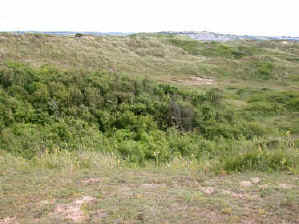Braunton Burrows is the largest sand dune system in
the UK. It hosts an extraordinarily diverse plant community, with over 400 recorded
species of vascular plants. This in turn means that there are also a great variety of
associated invertebrate species. Its uniqueness and biodiversity is recognised in its
designation as both a National Nature Reserve and as a UNESCO biosphere reserve. Braunton
Burrows is located in the South West of England, in North Devon, to the west of the town
of Barnstaple (map).
.
 |
The sand dunes are stabilized
and held in place by the root systems of a variety of creeping plants. Marram Grass, in
particular, is one of the pioneer species which colonize and stabilize the sand hills
piled up by the wind. The valleys between the dunes,
which are known as slacks, are wet and marshy in the winter and host a variety of marsh
herbs and low creeping shrubs. |
 |
Its name is derived from the
large numbers of rabbit burrows to be found in the area. The many rabbits have a profound
effect on the vegetation of the dunes through their grazing, in many places creating a
short, cropped turf of herbs and grasses. |
 |
Because of the continual
cropping by the rabbits, many of the plants are short and stunted and have an entirely
different growth form to their normal one. A number of the
plants are very small and a hand lens is essential to appreciate them! |
Continue
|